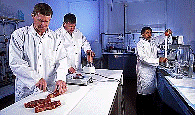United States Department of Agriculture: Agricultural Research Service, Lincoln, Nebraska

Roman L. Hruska U.S. Meat Animal Research Center: Reports
Date of this Version
1993
Document Type
Article
Abstract
Results from the first four cycles of the Germplasm Evaluation (GPE) Program at U.S. Meat Animal Research Center demonstrated that vast genetic variation exits among and within breeds for most bioeconomic traits in beef cattle. The range for differences between breeds was comparable in magnitude to the range in breeding value of individuals within breeds for most traits. Thus, significant genetic change can result from selection both between and within breeds. Breeds can be selected to optimize performance levels for important bioeconomic traits with a high level of precision much more quickly than intrapopulation selection.
No single breed or biological type excels in all traits important in beef production. Breeds with the greatest retail product growth potential excel in gain per unit feed consumed to wt and time endpoints; however, they also 1) sire progeny with heavier birth wt and increased calving difficulty; 2) produce carcasses with lower levels of marbling; 3) tend to be older at puberty if milk production has not been emphasized in their selection history; and 4) have heavier mature wt increasing nutrient requirements for maintenance. Use of crossbreeding systems that exploit complementarity by terminal crossing of sire breeds noted for lean tissue growth efficiency with crossbred cows with optimum size, milk production and adaptation to the feed and climatic environment provide the most effective means of managing these trade-offs.
Results from Cycle IV of the GPE program demonstrated that breeds that have been selected for muscular hyperplasia (Le., double muscling) may be an appropriate choice as a terminal sire breed to produce progeny (all steers and heifers would be slaughtered) suited for markets targeting lean-low caloric beef products. Piedmontese crosses ranked eighth (comparable to original Hereford Angus crosses) among the 11 breed groups in final wt, but ranked second to Charolais in wt of totally trimmed (0 mm) retail product due to exceptional dressing percentage and significantly higher retail product percentages than other breeds. Marbling was low in Piedmontese crosses, but estimates of meat tenderness were relatively high. Belgian Blue, another breed that has been selected for muscular hyperplasia, will be evaluated in Cycle V of the GPE program.
Bos indicus X Bos taurus crosses were exceptionally productive and efficient cows. A cooperative experiment conducted jointly at U.S. Meat Animal Research Center and the Subtropical Agricultural Research Station, Brooksville, FL revealed that advantages of Bos indicus X Bos taurus cross cows over Bos taurus X Bos taurus cross cows were even greater under subtropical climatic conditions than under temperate climatic conditions. However, the advantages of Bos indicus crosses were tempered by increased birth wt and calving difficulty when Bos indicus bulls were mated to Bos taurus females, older age at puberty, increased mortality when born in colder seasons in temperate areas and reduced meat tenderness as the proportion of Bos indicus inheritance increased. In Cycle V, tropically adapted breeds that have evolved separately for at least 2,000 yr from European Bos taurus breeds and Asian Bos indicus breeds will be sampled and evaluated.


Comments
Published in Beef Research Program Progress Report (1993) No. 4 (Part 1): 3-5